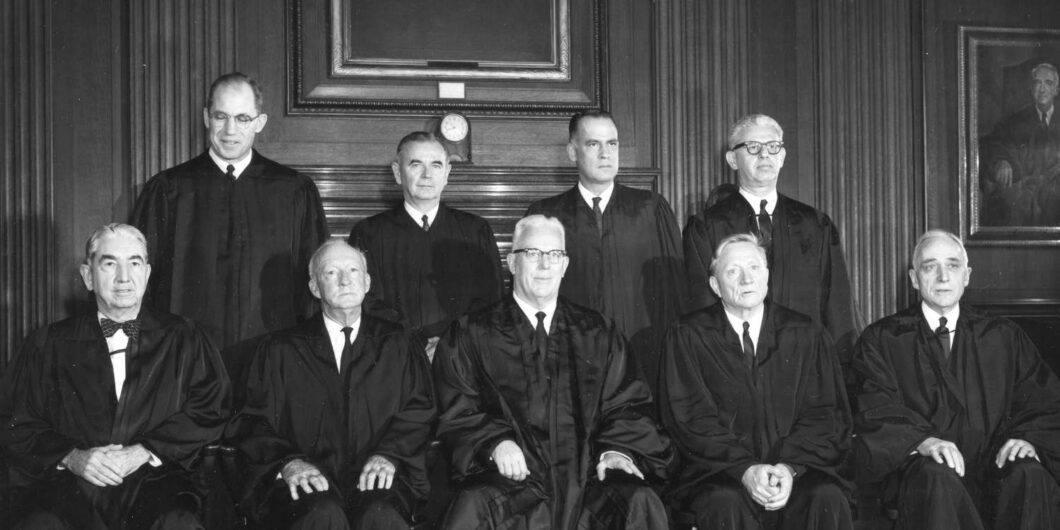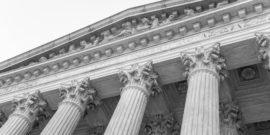Inventing Modern Libel Law
The 1964 Supreme Court decision in New York Times v. Sullivan is widely regarded as one of the most important First Amendment opinions of all time. In a unanimous opinion written by the Court’s most influential liberal Justice, William J. Brennan, the Court held that a public official cannot recover for the tort of libel—defined at common law as the publication of a false statement causing a person reputational harm—absent “actual malice” on the part of the publisher. In other words, the person seeking relief must demonstrate that the publisher acted with “knowing falsity” or “reckless disregard” of whether the statement was false or not. Although Sullivan did not purport to alter the law of libel for plaintiffs other than “public officials,” since 1964 the Court gradually expanded the scope of Sullivan, erasing common law libel protection for “public figures” such as celebrities, and even for private citizens who happen to “thrust themselves into the vortex” of a public controversy, whatever that means.
In one fell swoop, the Sullivan decision absolved the New York Times of a $500,000 libel verdict in favor of Birmingham’s police commissioner, L. B. Sullivan. The decision was rendered by an all-white Alabama jury during the height of post-Brown v. Board of Education resistance and based on the Times’ publication of a full-page fundraising ad by a civil rights group containing numerous false statements involving Sullivan and others.
Despite enjoying decades of reverence by the legal academy, Sullivan has rarely received the type of detailed scrutiny provided by University of Buffalo law professor and legal historian Samantha Barbas in her new book, Actual Malice: Civil Rights and Freedom of the Press in New York Times v. Sullivan. The background of Sullivan is fascinating, even if the “fly-on-the-wall” perspective Barbas provides leaves the reader feeling like Dorothy in The Wizard of Oz when she discovered who was really behind the curtain. In Sullivan, the presumed majesty of Supreme Court decision-making does not withstand an honest historian’s close attention.
Actual Malice has deservedly earned accolades from reviewers, with University of Tennessee law professor Glenn “InstaPundit” Reynolds pronouncing it “the best legal book I’ve read this year, and one of the best I’ve ever read.” High praise, indeed, for a book blurbed by UC Berkeley law school dean Erwin Chemerinsky and former ACLU president Nadine Strossen. I don’t quarrel with Reynolds’s assessment, including his observation that the book is “meticulously evenhanded.” The author, while obviously supportive of the Sullivan decision, is far more fair-minded than most legal scholars dealing with sensitive subjects.
Actual Malice is concise yet thorough, crisply written, brimming with sharp observations, amply documented, and admirably acknowledges different points of view. Refreshingly, Actual Malice is not a tendentious tract. It will likely supplant Anthony Lewis’s Make No Law (1991) as the definitive historical treatment of Sullivan. Barbas aims to explain the history of Sullivan, and not to debate its merits. I enjoyed the book very much and recommend it enthusiastically.
A Radical Decision
Sullivan is celebrated in liberal circles as a landmark Warren Court precedent protecting free speech and taking sides in the struggle for civil rights, but is the decision sound as constitutional law? Many prominent critics, including law professor Richard Epstein, Reynolds, the late D.C. Circuit Judge Laurence Silberman, Justices Clarence Thomas and Neil Gorsuch, and various conservative pundits and scholars, claim that Sullivan conferred on the media an unwarranted immunity from liability for publishing false statements, and accordingly has emboldened the fourth estate to become an increasingly aggressive—and partisan—combatant in the culture war.
The critics make a powerful case. To begin with, Sullivan was not, and did not pretend to be, an originalist decision. Written in 1964 during the heyday of Warren Court activism—the era of the “living Constitution”—Sullivan predated the ascendency of originalism decades later. Sullivan was a radical decision in several respects. It nullified the libel laws of all 50 states, which were in place at the Founding, and for “public officials” replaced the common law of strict liability for defamatory statements—a legal doctrine Barbas describes as “ancient,” whose roots date to the Middle Ages—with a legal standard drawn practically verbatim from the brief filed by the New York Times’ lead appellate lawyer, Columbia law professor Herbert Wechsler (who, ironically, during a WWII stint working for the DOJ, argued the infamous Korematsu decision before the Supreme Court). As Barbas observes, “An area of law that had been left up to the states was nationalized, with a constitutional floor established.”
“Actual malice” was a concoction of the NYT’s high-powered legal team, raised for the first time on appeal. The claim of a First Amendment defense to publish false statements—utterly at odds with the reputation-protecting goal of libel law—was never asserted at trial, for good reason. Prior to Sullivan, it was generally believed—and the Supreme Court had even frequently intimated in prior rulings—that libel, like obscenity, “fighting words,” and inciting insurrection, was outside the scope of the First Amendment. For centuries, Barbas points out, libel law existed to protect the “high value placed on reputation,” which was “often regarded as a form of property,” and “often described as a person’s most prized possession.” At the Founding, men dueled to defend their reputations. Libel was a serious matter.
Even Sullivan’s application of the First Amendment to the outcome of a civil action jury verdict—as opposed to direct state suppression of speech, or a criminal (or “seditious”) libel action—was a stretch. By its terms, the First Amendment constrains federal power (“Congress shall make no law …”), not the states. Moreover, the Times conceded that it failed to fact-check the error-ridden $4,800 ad—contrary to its normal practice—before rushing it into print. The Times was indisputably negligent in failing to review the ad copy and correct its obvious factual errors. Absent the sympathetic trappings of the civil rights movement, the case was a slam dunk for Sullivan, whose lawyer rightly believed the verdict was “bomb-proof,” unless the Court “changed the law of the land.”
Sullivan is not just bad constitutional law; it is also bad public policy.
But, as Justice Oliver Wendell Holmes once wrote, “Great cases, like hard cases, make bad law,” clarifying that a “great” case entails “some accident of immediate overwhelming interest which appeals to the feelings and distorts the judgment.” The prospect of the nation’s “newspaper of record” being bankrupted by a series of libel lawsuits filed in apparent retaliation for the Times’ leadership in reporting on southern resistance to court-mandated desegregation was simply inconceivable to the Warren Court. In the crucible of Bull Connor’s harsh opposition to peaceful civil rights protests in Birmingham (including the Freedom Riders), preserving the centuries-old common law of libel—and respecting the principles of constitutional fidelity and federalism—were the least of the Justices’ concerns.
The Court’s adoption of Wechsler’s novel “actual malice” standard would, Barbas acknowledges, require a “radical decision that would not only win the case for the Times but that would revolutionize libel law.” Sullivan succeeded in both respects. In hindsight, the ruling in Sullivan was motivated by the Court’s desire to crush resistance to desegregation in the Jim Crow South. But noble ends do not always justify unprincipled means, as Times advocate Wechsler himself recognized in his now-controversial 1959 critique of Brown v. Board of Education, a Harvard Law Review article entitled “Toward Neutral Principles of Constitutional Law.”
Aftermath
Critics charge that Sullivan unleashed a reckless and unaccountable media juggernaut. As Barbas notes, “It’s better for journalists not to investigate—the more a reporter uncovers, the more likely it is that they will discover facts that call into question the truth of the story, making them more likely to be held liable for acting with actual malice.” In order to promote “robust” debate, create “breathing space” for free expression, and avoid “self-censorship” by a liability-averse speaker, Sullivan invented out of whole cloth a First Amendment right to defame public officials with impunity. (Justices Hugo Black and William O. Douglas would have gone further than Brennan’s opinion for a unanimous Court, urging a constitutional privilege to libel public officials even with knowingly false statements.) The news media understandably exulted at being liberated from accountability for libeling public officials—being placed above the law.
A growing chorus of Sullivan critics, led most prominently by Justice Clarence Thomas, urges that the decision be overturned. The “actual malice” standard has no basis in the original understanding of the First Amendment. Thomas’s powerful concurring opinion in McKee v. Cosby (2019) made the case for overruling Sullivan as an extra-constitutional usurpation of state law that allows reputation-damaging false statements to go unremedied. In 2021, the late Judge Laurence Silberman of the D.C. Circuit wrote a passionate dissenting opinion in Tah v. Global Witness, citing Justice Thomas and urging the Supreme Court to overrule Sullivan, which he cheekily described as “policy-driven decision masquerading as constitutional law.” Thomas, joined separately by Neil Gorsuch, continued his originalist critique of Sullivan in a 2021 dissent from the Court’s denial of certiorari in Berisha v. Lawson.
Sullivan is not just bad constitutional law; it is also bad public policy. Relieved of accountability for false reporting, the news media routinely smears people for political reasons and sensationalizes stories for ratings, in both cases often damaging the subjects’ reputations in the process. The remarkably-biased coverage of the George Zimmerman, Nicholas Sandmann, and Kyle Rittenhouse incidents are just a few examples. Carson Holloway, Mark Hemingway, and others have argued that Sullivan and its progeny have contributed to irresponsible, sloppy, and agenda-driven news media, at the expense of fairness, accuracy, and reputational integrity.
As Lord Acton wisely observed, untrammeled power tends to become tyrannical. Sullivan improperly eliminated legal responsibility for defamatory and libelous reporting, and until accountability is restored by overruling the “actual malice” standard, the playing field of public debate will be tilted dangerously in favor of anonymous sources, lurid innuendoes, selective editing, false allegations, and other media abuses. Sullivan did not improve public debate; it impoverished it. Objective journalism requires discipline, which prior to 1964 was provided by the common law of libel. It is time to reinstate that much-needed discipline.



